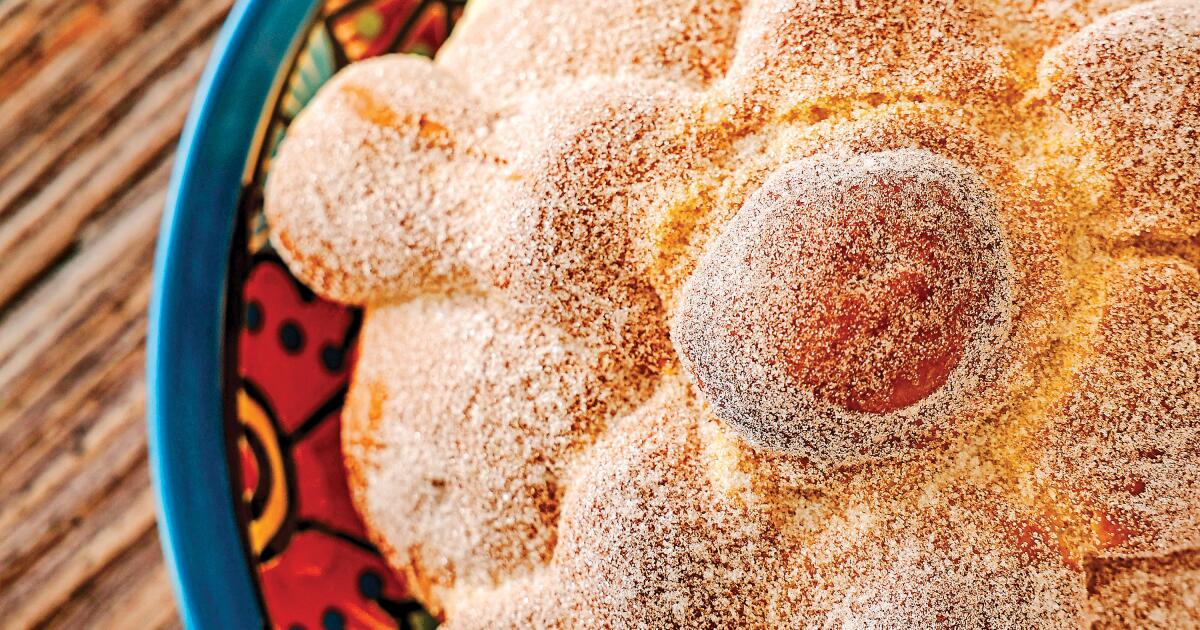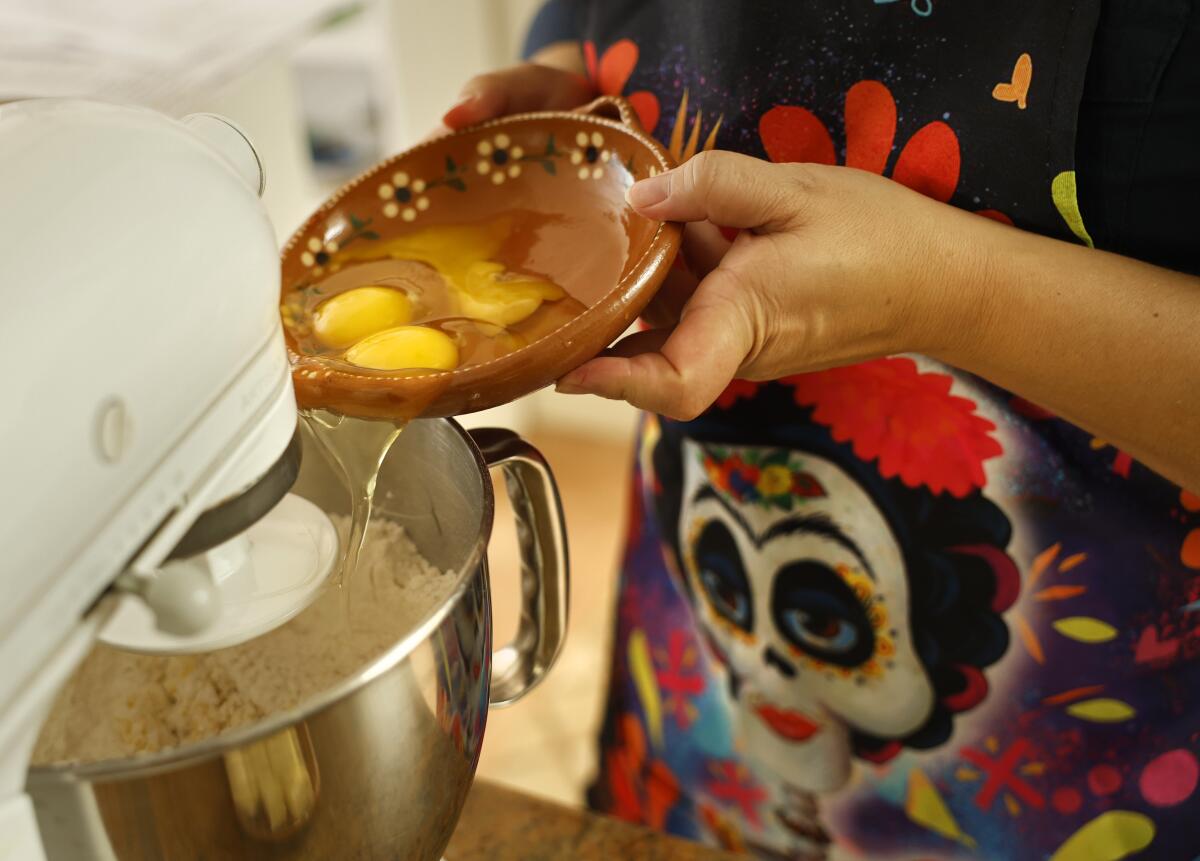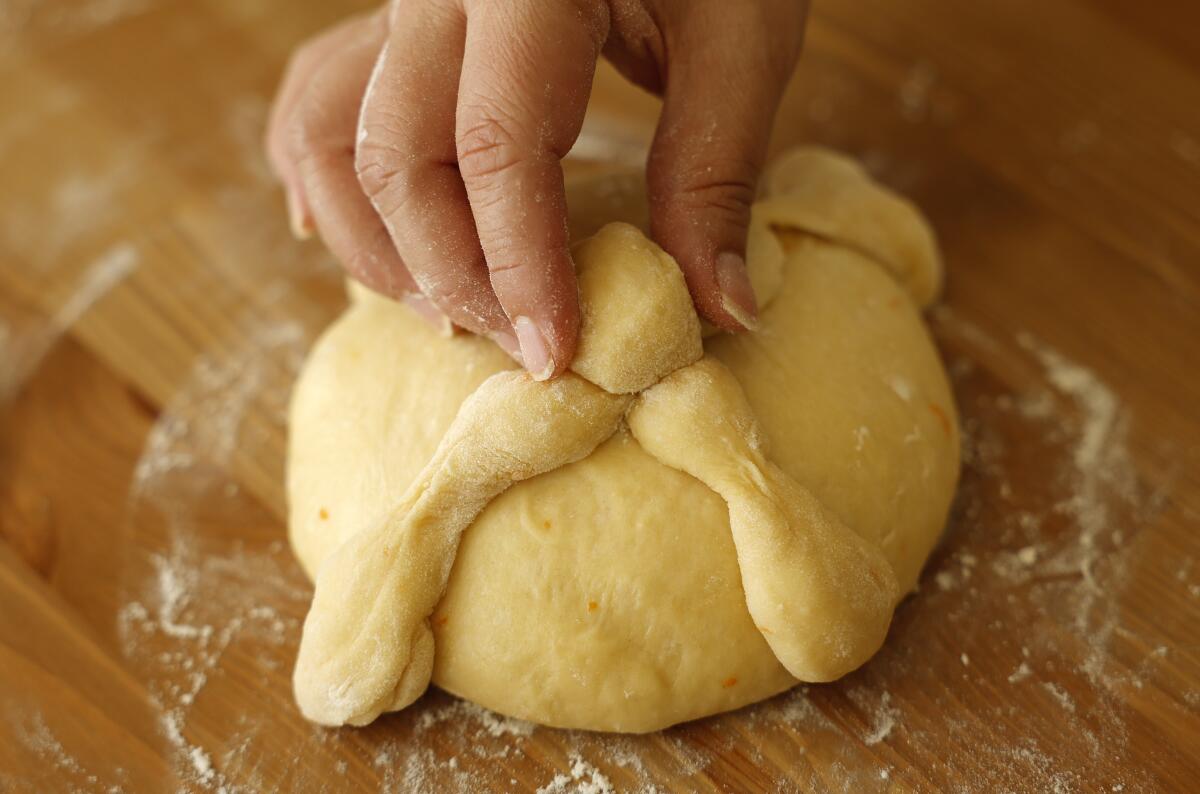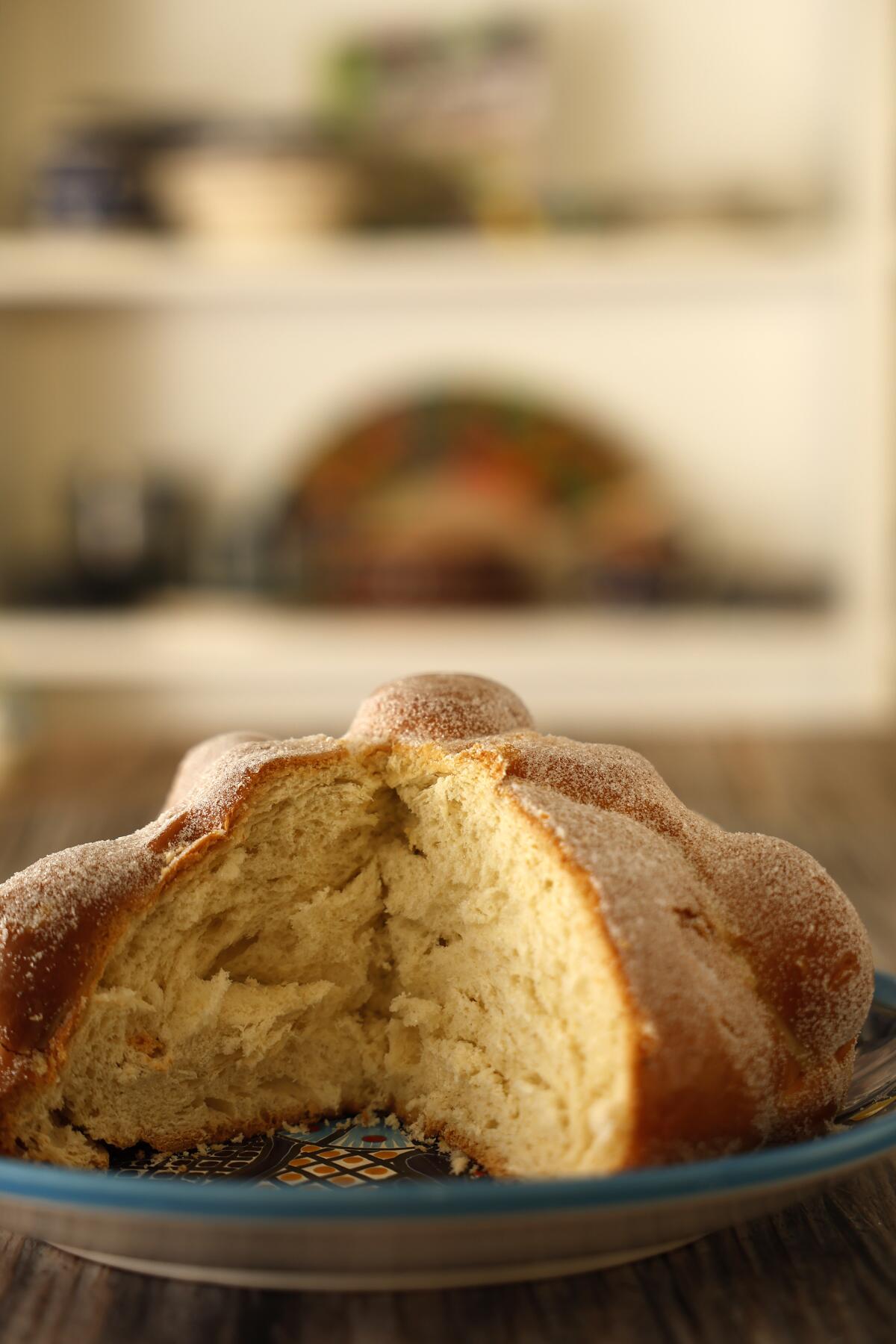
One of the most moving experiences in my travels happened just on the other side of the Mexican border about 14 years ago, while walking in and around Miguel Hidalgo Park in Tecate, during its Día de los Muertos festival.
Here were dozens of family altars, or ofrendas, each unique, honoring their late loved ones with photos, food, liquor and artifacts that recalled the passions of their life — a baseball here, a cigar or favorite meal or stuffed animal there. Interspersed were Catrina dolls — those dramatically painted and outfitted skeletal figures — and calaveras, equally dramatic skeletons and sugar skulls. Candles were lit and marigold petals scattered. At each stop in front of an altar, I got a sense of the person being mourned and celebrated. Their essence came alive.
In the U.S., we may associate Día de los Muertos — celebrated annually on Nov. 1 and 2 — as a Mexican version of Halloween. But the roots of Día de los Muertos go back thousands of years to rituals that honor the dead in pre-Columbian Mesoamerica. Those Indigenous rituals eventually merged with the celebrations of the Catholic holidays of All Saints Day and All Souls Day that Spanish conquistadors brought with them to the New World in the 16th century, eventually creating a uniquely Mexican celebration that welcomes the souls of the dead.
But according to Coronado resident Maggie Unzueta, creator of the popular Mamá Maggie’s Kitchen blog, the people of her family’s homeland in the state of Durango, Mexico, only observed Día de los Muertos as a religious holiday, which involved attending Mass and visiting the cemetery.
“We did not build altars. Instead, we had coronas de flores [crowns made of flowers] to lay on the tombstones of our deceased loved ones,” she explained. “I still remember the endless hours of praying the rosary.”

Food blogger Maggie Unzueta prepares pan de muerto at her home in Coronado.
(K.C. Alfred / The San Diego Union-Tribune)
Celebrating with altars is a more recent adoption in Northern Mexican states. Unzueta attributes it to, among other things, the 2017 release of Disney’s animated movie, “Coco,” which tells the story of a young aspiring musician who enters the Land of the Dead to find an ancestor who had been a singer.
“I want to thank Disney because it really opened our eyes to other traditions within Mexico that we weren’t aware of,” she said.
Unzueta, who launched her blog in 2010 and fills it with recipes she’s adapted from those of her beloved maternal grandmother and other family members, has since found new meaning in Día de los Muertos. She got emotional when talking about the passing of her grandmother and explained that, to her, the holiday “is all about celebrating and honoring our dead, keeping their memories alive.”
There are many favorite dishes people enjoy to celebrate the holiday, but pan de muerto is its most traditional food. The so-called Bread of the Dead is a round, sweet egg bread with a hint of orange flavor that features a cross in the shape of “bones” laying across it with a “head” on top. After baking, the bread is brushed with melted butter and then lavishly sprinkled all over with sugar. It reminded me of a sweet challah — perfect with a cup of coffee or perhaps a steaming mug of champurrado, a thick chocolate Mexican drink.
Another bread Unzueta makes for Día de los Muertos is pan de elote, or cornbread. But it’s nothing like traditional Southern cornbread. It’s a sweet corn cake redolent of cinnamon and vanilla, filled with pieces of corn in a dense, almost puddinglike dough that includes both sweetened condensed milk and evaporated milk, along with plenty of eggs.

To make the pan de muerto, start by blooming the yeast (see recipe). Then add sugar to the mixing bowl and sift in the flour and salt.
(K.C. Alfred / The San Diego Union-Tribune)

Use 3 whole eggs plus 3 egg yolks; crack them into a small bowl.
(K.C. Alfred / The San Diego Union-Tribune)

Add the eggs one at a time to the mixing bowl; the butter, milk and zest come next.
(K.C. Alfred / The San Diego Union-Tribune)
Making Pan de Muerto isn’t difficult and is something kids would enjoy helping with. The most time is spent letting the dough proof a couple of times. You start by prepping the yeast in warm — not hot — water and sugar. If you have a stand mixer, add sifted flour and salt to the bowl before adding the activated yeast mixture and mixing on low to combine. Then you’ll add the eggs one at a time, followed by softened butter, milk and orange zest. If you can find agua de azahar, or orange blossom water, you can use that instead of orange zest (or with, for a profoundly orange flavor) and reduce the amount of milk. With all the ingredients blended you’ll have a wettish dough that’s ready for kneading. Using either your hands or your mixer’s dough hook, knead until the dough is soft but a little tacky. If it’s still too wet, add just a pinch more flour, but no more, to avoid a tough texture.

Cut dough into three equal pieces. Shape two into balls. Shape the third piece into a flat rectangle, slicing it into 5 equal pieces. Roll 4 of those pieces into logs.
(K.C. Alfred / The San Diego Union-Tribune)
Now the dough gets its first rise. After an hour, flour your work surface and pull the dough from the bowl. This dough can make one massive loaf, two large loaves or several smaller ones. Assuming you’re making two loaves, divide the dough evenly into three equal pieces. One piece is set aside to make the “bones” and “heads.” With the other two, which will become the bodies of the loaves, create two round balls, smoothing the dough from the top over the ball to the bottom, where you’ll have a seam.

With the 5th piece of dough, cut it in half and shape it into a ball for the center of the bread.
(K.C. Alfred / The San Diego Union-Tribune)

Drape 2 logs crisscrossed over each large dough ball. Add the smaller dough ball at the center of the cross.
(K.C. Alfred / The San Diego Union-Tribune)
Unzueta created a flat rectangle with the remaining third piece, which she then divided into five equal pieces. Roll out four of those into strands just long enough to fully drape over the loaves. With each, spread and place your three middle fingers on top and press down to create indentations. Remember that as these rise a second time and then bake, they’ll get puffy, so these indentations need to be distinctive. These are your “bones.” Divide that fifth piece in two and roll into small, smooth balls to create the “heads.”
To put them together, you’ll lightly brush water to make a cross over each of the two loaves, then place one “bone” across the center of each loaf. Brush the top of each bone and drape the second over it to make an X. Brush the top of that and place the little ball. Cover and let rise again for an hour, then bake.
Once each loaf has cooled a bit out of the oven, brush all over (except the bottom) with melted butter, then balance each over a bowl and sprinkle generously with sugar, letting the excess fall into the bowl. They’re now ready to serve.
The pan de elote is very simple to make. Gather all your wet ingredients, leaving out half the corn, and put them in a blender, pureeing until smooth. Then add the remaining corn and blend until the texture is right for you. In a mixing bowl, stir together the flour, baking powder, salt and cinnamon. Then add the corn mixture and blend well. Pour into buttered and floured pans and bake. That’s it.
I’d easily take these over itty bitty Mounds bars and Skittles every year.

After cooling, pan de muerto is brushed with butter and sprinkled generously with sugar.
(K.C. Alfred / The San Diego Union-Tribune)
Pan de Muerto (Bread of the Dead)
Makes 2 full-size loaves, 1 very large loaf or several smaller ones
FOR THE YEAST:
¼ cup warm water
3½ teaspoons active dry yeast (or 1½ packages)
1 teaspoon sugar
FOR THE DOUGH:
¾ cup sugar
4 cup all-purpose flour
¾ teaspoon salt
3 whole eggs, room temperature
3 egg yolks, room temperature
⅔ cup butter, softened
½ cup warm milk
Zest from 2 oranges
¼ cup water (to brush on the bread so bones and head adhere to the dough)
FOR THE TOPPINGS:
¼ cup melted butter
1 cup sugar
Bloom (activate) the yeast: Dissolve the yeast in warm water. Add sugar. Mix well. Set aside for about 5 to 10 minutes. Water must be a maximum of 110 degrees, or you will kill the yeast.
Make the dough: Add sugar to a large mixing bowl or stand mixer. Sift the flour and salt into the bowl. Create a small well in the center of the flour mixture. Add the activated yeast. Mix on low to combine.
Add the eggs and egg yolks one at a time. Add the butter little by little until fully mixed. Next, add the milk and orange zest. The mixture will appear wet.
Knead (using the hook attachment for the KitchenAid) for 20 to 25 minutes until the dough is just a little tacky, but your fingers shouldn’t have dough on them after touching. If they do, add just a pinch more flour, but no more, or the result will be a tough bread.
If kneading by hand, knead for 30 minutes. The dough is ready when it doesn’t stick to your hand.
Place the dough in a well-oiled bowl. Cover and proof for 1 hour in a warm spot until the dough rises.
Add all-purpose flour to a work surface.
To make two loaves, cut the dough into three equal pieces. Set one piece aside. Using the other two pieces, create two round balls. The seams of each should be on the bottom, and the tops should be smooth. These will be the two breads.
Using the third piece of dough, create a flat rectangle. Cut into 5 equal pieces. Separate 4 of the pieces and roll out each piece so it’s long enough to drape over the ball. Create deep indentations on each of the 4 with your middle three fingers to create the look of bones.
Cut the remaining 5th piece of dough in half. Form each into a small ball to create the heads for each loaf.
Using a pastry brush, lightly brush water in a crisscross on each bread dough. Drape one “bone” across the center of the dough over one track of water. Brush the top with a little water and set the second “bone” across the first and over the second track of water to create an X. Brush a little water on the top center where the bones meet. Place the remaining ball in the center on top to create a head. Cover and let rise for a second proof, lasting 1 hour.
Preheat the oven to 350 degrees. Bake 20 to 25 minutes for 1 bread or 25 to 30 minutes for 2 breads. Stick a toothpick in the center of each loaf. If it comes out clean, your bread is ready. If not, return to the oven for another 5 minutes.
Cool slightly on a rack.
Brush the melted butter all over the top of the breads.
Sprinkle each loaf all over with sugar. Do this over a bowl to catch the excess.
Serve and enjoy!
Notes:
Substitutions: If using Agua de Azahar Orange Flower Water, use ⅓ cup milk plus 3 tablespoons of the orange blossom water.
Instead of milk, you can also use evaporated milk.
Pro tip: Do not use hot water to activate the yeast, or you will kill it. Also, look at the expiration date on the package. If it’s past the expiration date, the yeast is no longer good.

Pan de elote is a sweet corn cake with cinnamon and vanilla and pieces of corn in a dense dough, almost like a pudding.
(K.C. Alfred / The San Diego Union-Tribune)
Pan de Elote
Makes 8 servings
1 stick (½ cup) butter (including small amount needed to butter the pan), room temperature and sliced
1¾ cups plus 2 tablespoons flour, divided
5 eggs
1 can (14 ounces) sweetened condensed milk
½ cup evaporated milk
1 tablespoon vanilla
6 cups of corn or 8 ears of corn, kernels removed
2 tablespoons baking powder
Pinch of salt
1 teaspoon cinnamon
Preheat oven to 350 degrees.
Butter, then flour either two 9-inch cake pans or a 13-by-9-inch baking pan, using 2 tablespoons flour.
Add remaining butter, eggs, sweetened condensed milk, evaporated milk, vanilla and half the corn to a blender. Blend until smooth.
Add the remaining corn and blend. (For more corn texture, blend slightly. For less corn texture, blend until smooth.)
In a bowl, stir together 1¾ cups of flour, baking powder, salt and cinnamon.
Add the corn mixture to the dry ingredients. Stir until well combined.
Pour the batter into the pan. Bake for 45 minutes or until a toothpick comes out clean.
Storage notes:
Pan de elote freezes extremely well. Place in a sealable freezer bag. Remove as much air as possible. Store for up to 6 months.
In the fridge, pan de elote only lasts up to 7 days, or frozen for up to 6 months in a sealable plastic bag with as much air as possible removed.
Recipes by Maggie Unzueta.
Golden is a San Diego freelance food writer and blogger.






